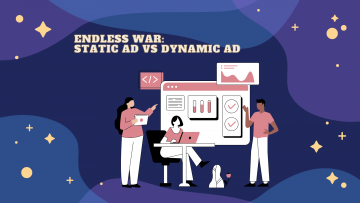
ENDLESS WAR: STATIC AD VS DYNAMIC AD
 30-05-2022
30-05-2022
For publishers struggling to decide whether to use dynamic or static ad formats, this is the article for you.
Today's advertising market is increasingly diverse in terms of display formats and placements. But we can divide them into two main types of ad formats: static ads and dynamic ads. Up to 70% of publishers will definitely choose dynamic ads only because they think it is the format that will drive their ad revenue to grow. But is that true? Let's find out together!
With static ads that work well and are displayed in the correct position, it solves almost any problem. But publishers, because they want to target a group of potential customers, choose to use dynamic ads.
Let's take a closer look at static ads. Static ads here are not just banners that don't move, but static ads are ads that don't move, customized to different locations. This is the best way for magazine publishers to perceive their brand among a large audience. In addition to not focusing primarily on a specific customer group, it does not require much creativity and is always supported by most ad networks.

Some advantages can be mentioned of this format, such as:
- Adaptable: The static ad format is designed to fit both desktop and mobile screens. Any industry or brand can use this type of advertising effectively.
- Convenience: Because they do not require technical expertise, do not take too much time and do not require creativity, they become very convenient for everyone. The feature of this format is that it does not move in different locations, so publishers do not need to worry about frequent updates or maintenance.
Best suited for small-scale publishers: Because it doesn't require too much technical work or frequent editing to retarget or change content, it is suitable for publishers. small-scale publishing, without many resources.
In addition to the advantages, they also have obvious disadvantages:
- Limited audience: Usually, static ads are only fixed in a certain position to reach as many audiences as possible, not segmenting customer groups. And this format often doesn't get a lot of interaction and feedback.
- Limit personalization: Today's ads are often personalized, customized according to the user's preferences and habits. But static ads lack the creativity to be suitable for different users.

Static ads are also used with many different ad formats such as: images, animations, videos, text or banner ads, etc. It is very effective if used in the correct places. These are usually fixed at pages: Social media profiles, ebooks, PPC banners or ads, Landing pages on a website, one-way webinars.
For a fair comparison, we also need to learn more about Dynamic ads. Called main dynamic ads because their content is diverse, changing depending on user behavior and other available data. Dynamic ads are created with the purpose of targeting a specific audience to deliver relevant messages.
Although born later, the advantages of this format are more optimal:
- Interaction and personalization: Changes are based on shortened data about the user's interests, needs, next step after viewing the ad, etc. with this information, the displayed advertisement will more appropriate to user needs.
- Brand loyalty: By collecting a lot of information and user habits, dynamic advertising will give brands the opportunity to reach more specific customers. Like if a customer already has a product in the cart of a brand, the ad will display similar priced products for customers to consider.
- Brand loyalty: By collecting a lot of information and user habits, dynamic advertising will give brands the opportunity to reach more specific customers. Like if a customer already has a product in the cart of a brand, the ad will display similar priced products for customers to consider.
- Higher visibility: Not only users but also search engines appreciate and respond positively to dynamic ads. It is thanks to this active support that this ad format will have a greater chance of being shown.
However, it is impossible not to mention the disadvantages of dynamic ad:
- Expensive advertising costs: Also because of the automation in the maintenance and upgrading of ads, the price of dynamic ads will be more expensive. And price is one of the criteria that advertisers will consider to decide whether to use this format or not.
- Efforts on demand: Unlike static ads, dynamic ads require a certain understanding of the publisher's technical and creative skills to be able to change content more often and update more often. content for users.

With the above simple comparison, hopefully publishers can consider which ad format. Not only that, if you decide to use both ad formats, you can also refer to them to increase your revenue. In case you need more advice on how to use a combination of both ad formats appropriately, you can leave contact information below the article or email Netlink: sale@appmatic.sg.

